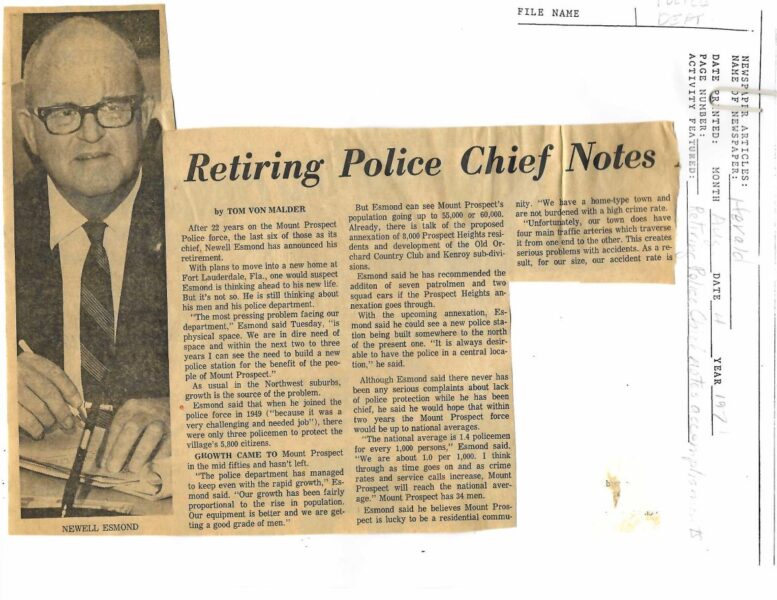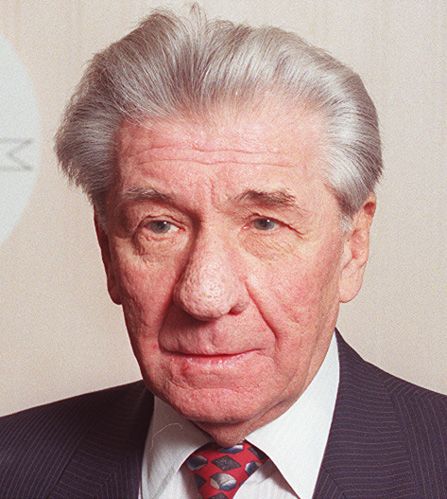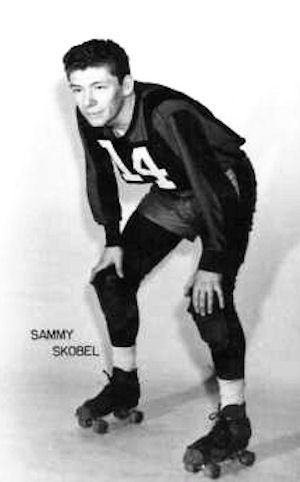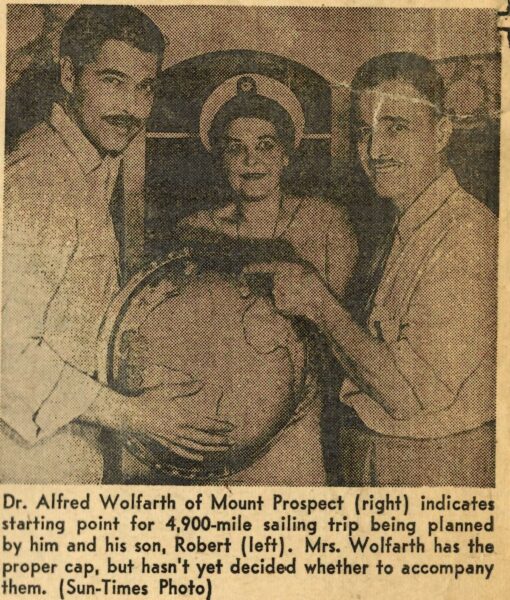Does MPHS have photographs: Maybe
Address in MP:
Birth Date:
Death Date:
Marriage:
Date:
Spouses:
Children:
Interesting information on life, career, accomplishments:
By MPHS User
Does MPHS have photographs: Maybe
Address in MP:
Birth Date:
Death Date:
Marriage:
Date:
Spouses:
Children:
By MPHS User

Does MPHS have photographs: Yes
Address in MP:
Birth Date:
Death Date: circa 2021
Marriage:
Date:
Spouses:
Children:
He spent a lot of time investing in Mount Prospect with his work as the police chief.
By MPHS User
Edwin C. Wille was born December 2, 1895 in Elk Grove Township, Illinois. His father, William, was a German immigrant who worked as a carpenter. His mother, Engel, was born in Illinois. According to the United States Census records Edwin lived with his parents and 7 siblings in 1900 and with his parents and 6 siblings in 1910. According to his World War I Draft Registration card by June 1917 Edwin worked as a bartender for his father. He noted on the form that “I am willing to fight for my country to defend it and not for other countries outside of USA.” Edwin did end up enlisting in the military on October 5, 1917 and was discharged on June 5, 1919. He served with Co. A, 129th Infantry. When he returned home, Edwin lived with his parents, three siblings and four nieces and nephews in Mount Prospect on Busse Avenue and worked as a carpenter. He married Margaret D. Behrens of Des Plaines on June 29, 1929. He and Margaret lived at 104 William Street in 1930; Edwin continued to work as a carpenter. He was elected as a Mount Prospect trustee on the Progressive ticket in April 1932. During this term he served on the board’s street and sidewalks, fire and water, and police and lights committees. Edwin won reelection in 1935 when he ran on the Community ticket. He served as chairman of the police committee and continued work with the fire and water and streets committees. Edwin left the board of trustees in 1937. By 1940 Edwin and his wife, Margaret, had three children, a daughter and two sons and lived at 22 Busse Avenue in Mount Prospect. Edwin worked as a beer distributor. On the World War II Draft Registration form Edwin indicated he worked for himself but did disclose the kind of business. In 1950 he was again living at 104 S. William now with his wife, son, daughter, son-in-law and granddaughter. His profession is listed as carpenter. Edwin’s wife, Margaret, died in 1972. Edwin Wille died on March 17, 1980. He is buried in Memory Gardens cemetery in Arlington Heights.
By HS Board

Samuel “Sammy” Skobel was an American roller derby skating star who opened a hot dog restaurant in Mount Prospect after his retirement from his sport.
Legally blind, Skobel was a derby star who was voted most valuable player in the league three times and inducted to the Roller Derby Hall of Fame in 1953. Skobel also held the world record for the fastest mile skated on a banked track – accomplished in 1958.
Sammy was born to Russian immigrants on April 26, 1926. His parents owned a grocery and meat market on Chicago’s Maxwell Street.
An infection with scarlet fever at the age of four left him legally blind, with less than ten percent of his vision remaining.
A track star at Crane Technical High School, he ran a 4:22 mile and was offered full scholarships to three universities, but those offers were rescinded when the schools learned he was legally blind. He had a hard time finding and maintaining a job after graduating from high school. In fact, he was denied a job in an electronics factory and got fired from a job repairing innertubes after just a few hours.
In 1945, Skobel tried out for the roller derby at the Chicago Coliseum but was rejected after the general manager of the Roller Derby watched him struggle to fill out the application with a magnifying glass. Instead, Skobel joined the roller derby working as a locker attendant, earning 50 cents per day.[ He worked in the center of the banked-track ring, memorizing the styles and outlines of the skaters. When he heard that the derby was holding tryouts in Chattanooga in January 1946, he traveled there by bus and was able to keep his low vision a secret during trials. He signed with the Brooklyn Red Devils in 1946, keeping his disability a secret for the first five years he played. Skobel would listen for the sound of an opponent’s skates coming up behind him, and if a skater was close he could see whether they were wearing stripes or certain colors.

In 1949, Skobel became the youngest team captain in the history of the sport. Skobel was traded to the Chicago Westerners in 1953, where he skated for twelve seasons. He skated for the IRDL Midwest Pioneers from 1964 to 1966. He had several nicknames throughout his career, including “Slammin'” Sammy Skobel and “Gunner” Skobel.
Skobel was voted the league’s Most Valuable Player of the year three times during his skating career and was on 18 all-star teams. He was one of the first seven people inducted to the original Roller Derby Hall of Fame in 1953 and in 1958 set a world record fastest mile on a banked track, skating the mile in 2 minutes and 36 seconds.
By the end of his career, he was paid $80,000 each season. He skated his last game in May 1966, but would later serve as a consulting coach for the San Francisco Bay Bombers.
Skobel married his wife Acrivie (“Vee”) in 1952. They had two sons together, Sam Jr. and Stephen.
After retiring from the roller derby, he opened Sammy Skobel’s Hot Dogs Plus in downtown Mount Prospect. He ran the restaurant from 1965 to 1989, when he sold it to a former employee. He also traveled as a motivational speaker, giving talks on “Creating a Positive Attitude for Life,” and advocated for other blind athletes. For instance, in 1971 he helped found the American Blind Skiing Foundation.
In 1982, Skobel collaborated with a freelance writer to write his autobiography, titled Semka. The jacket described the book as the “story of a determined young blind man from his boyhood in Chicago’s Maxwell Street to a professional athletic career, setting a world speed skating record.”
Skobel died on June 9, 2018 at age of 92 in his home in Mount Prospect.
By HS Board

Does MPHS have photographs: Misc. Images
Address in Mount Prospect: 113 W. Prospect
Birth Date: Circa 1899
Death Date:
Marriage
Date:
Spouse: Caroline
Children: Robert (maybe others)
Dr. Wolfarth was the second doctor in Mount Prospect. His first office was in the Busse Building in Busse Ave, directly above Busse-Biermann Hardware. Working with Dr. Louise Koester, the only other doctor in Mount Prospect, a small hospital was set up for car accidents and emergencies. Dr. Wolfarth supplemented his local business by also being the physician on call for the Mount Prospect Fire Department and the Chicago Northwestern Railroad. During World War II, Dr. Wolfarth left Mount Prospect and served as a doctor at an evacuation hospital for troops of General George Patton. In 1957, he and his wife, son and family friend decided to sail across the Atlantic on a 43 foot boat. They sailed from Germany to New York and then up the Hudson and the Erie Canal to the great lakes and Chicago. This traced the path that many settlers in Mount Prospect would have taken. None of the four people on the boat had extensive experience sailing, so this was a pretty brave trip. It took them four months and 8,000 miles.
Mount Prospect Historical Society
101 South Maple Street
Mount Prospect, IL 60056
847.392.9006
info@mtphistory.org
The Mount Prospect Historical Society is a 501(c)(3) nonprofit organization that is committed to preserving the history of Mount Prospect, IL, through artifacts, photographs and both oral and written memories of current and former residents and businesspeople. On its campus in the heart of the Village, the Society maintains the 1906 Dietrich Friedrichs house museum, the ADA-accessible Dolores Haugh Education Center and the 1896 one-room Central School, which was moved to the museum campus in 2008, renovated and opened to the public in 2017, the 100-year anniversary of the Village.